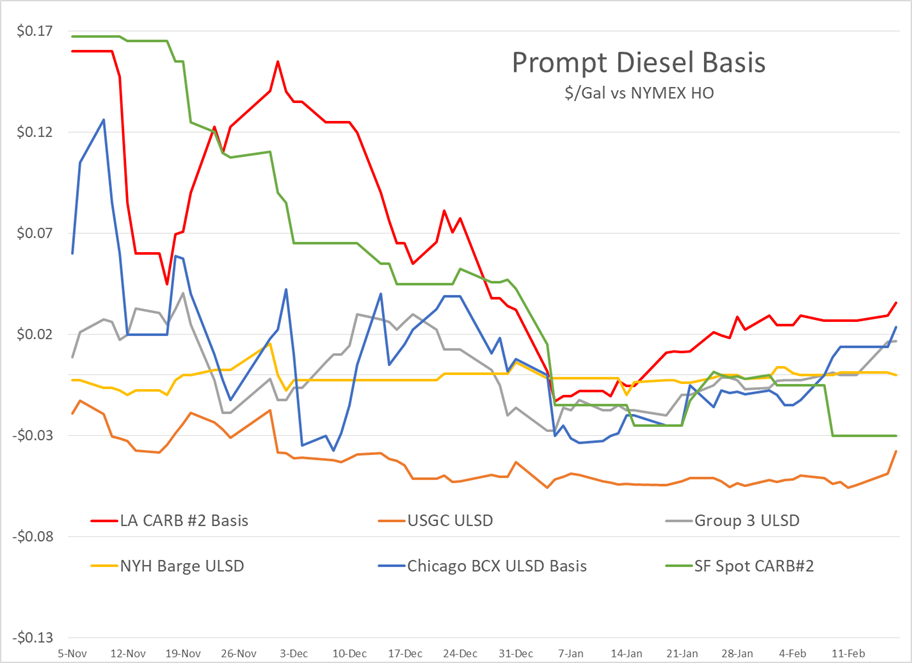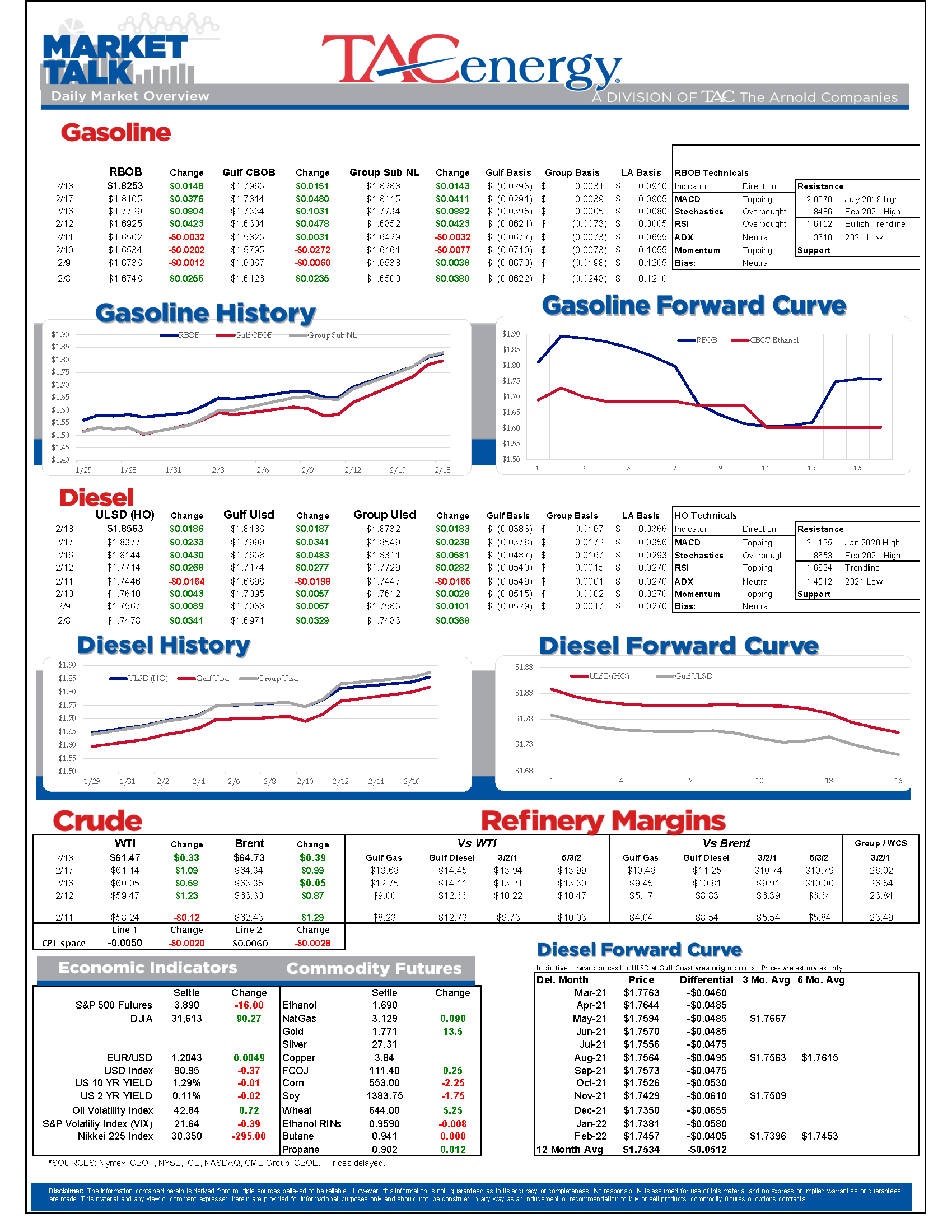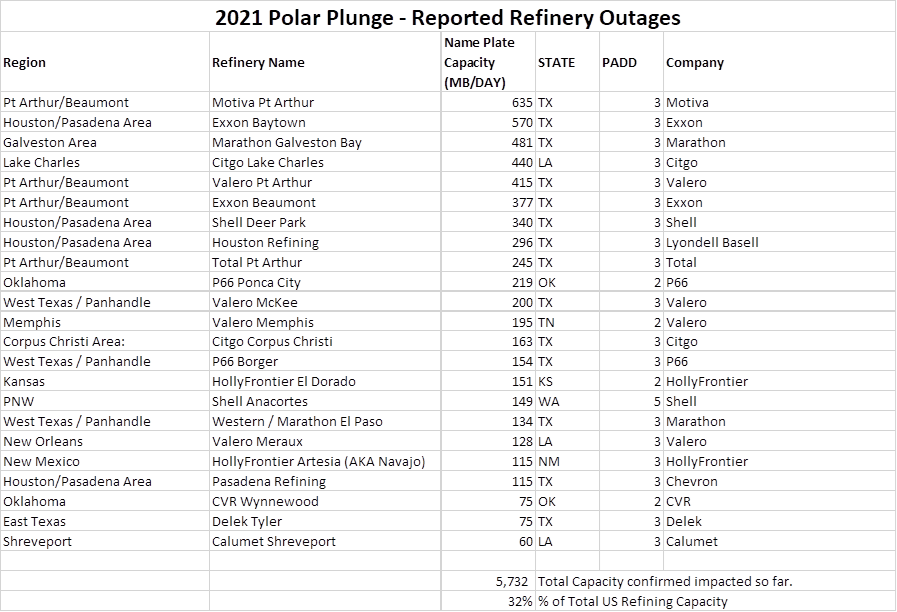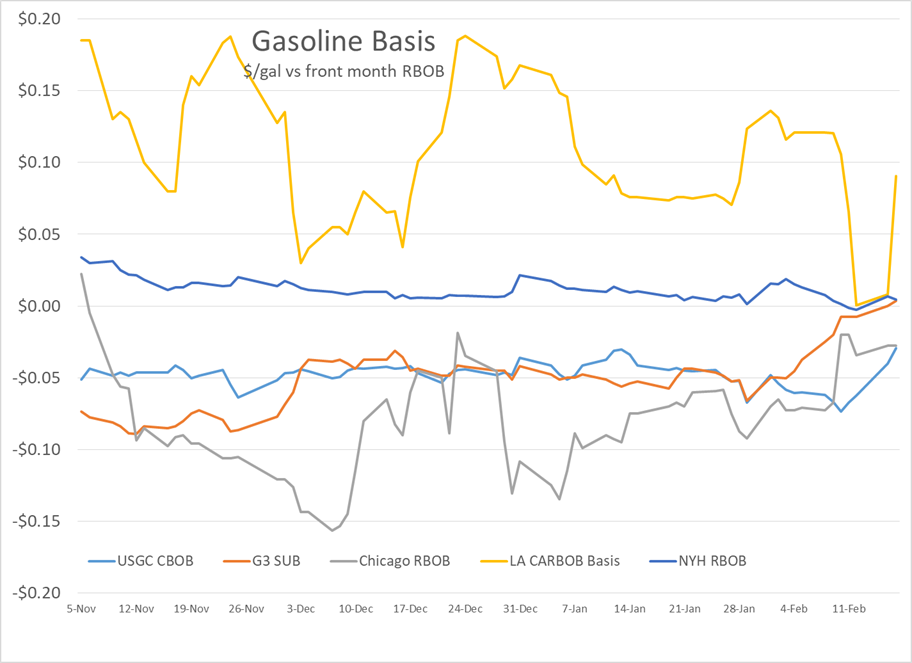How Long Until Power Comes Back On?

How long until the power comes back on? That’s the big question being asked by millions of people across the U.S. and Mexico, and a huge proportion of the energy industry as the remnants of a brutal stretch of winter weather moves East, and the thawing out process begins. In addition to the direct impact, the trickle down effects of the collapse in oil, refined products, natural gas and ethylene production are being felt around the world.
The refining hubs along the Gulf Coast from Corpus Christi to New Orleans have temperatures above freezing this morning, and should stay that way for the next week, except for a few hours tonight. If that thaw allows most plants to resume operations by the weekend, the impact of this chaotic event should be short-lived. Of course, the warm up also means that more drivers are about to hit the road, while terminals and stations that have been closed for a few days may or may not be able to come back online with supply, power and/or intact pipes to meet demand.
If you remember the panic buying in the wake of Hurricane Harvey, it’s not hard to imagine that the next few days could create a demand spike as news of the refinery shutdowns hits the mainstream just in time for people to start leaving their homes again, and could create a preventable panic phenomenon which could create supply shortages all on its own.
The Houston ship channel was able to resume limited operations after the ice blocking shipping lanes started to break up, a most unusual occurrence that may have some Texans reluctant to use the phrase “When Hell Freezes over” ever again.
We did see some heavy selling for about an hour Wednesday morning after a WSJ report that said Saudi Arabia was going to increase its oil output now that prices had recovered. That wave of selling wiped out the early gains for crude and product futures, but was fairly short lived and the march higher picked up later in the morning.
Basis markets continue to show strength for both gasoline and diesel grades across most U.S. spot markets, but those moves are still relatively minor compared to disruptions we’ve witnessed over the past two decades, a testament to the excess capacity in the U.S. and the softer-than-normal demand environment. In addition to stronger spot prices, numerous rack markets stretching from Arizona to Maryland have switched from seeing suppliers having to offer steep discounts to move product during the winter doldrums, to enforcing strict allocations as resupply options become questionable.
The API reported large draws in oil and diesel stocks last week, while gasoline stocks had another large build. The DOE’s weekly report is due out at 10 a.m. central today, and should give some glimpse into the impact on gasoline demand caused by the winter storms that battered the East Coast two weeks ago, that now appear quaint in comparison. Don’t expect the report to move the market much as last Friday’s data doesn’t mean much after almost 1/3 of the country’s refining capacity was forced to cut back this week.
In other non-frozen refinery news this week, Calumet laid out plans to convert part of its Great Falls Montana facility to Renewable Diesel production this week in an SEC filing, joining a long list of refiners looking to jump on the BTC/RIN/LCFS and new Canadian CFS programs that combined can offer more than $4.50/gallon in subsidies for RD production. The company also closed on the sale and leaseback of its Shreveport facility in an effort to save enough cash to survive the weak margin environment that was hammering refineries before the storms hit.
Great Falls Renewable Diesel Opportunity:
We believe Great Falls, which connects western agriculture with West Coast and Canadian clean product markets, presents one of the most compelling opportunities for Renewable Diesel production in North America. We estimate the oversized hydrocracker built in 2016 can be reconfigured to process 10-12,000 BPD renewable feedstock at the lowest capital cost per barrel of any announced industry project. Hydrocracker conversions are typically faster to market, cheaper, and less technically challenging. In addition, the planned configuration could retain 10-12,000 BPD low-cost Canadian crude processing, providing Montana customers with clean energy and our unique specialty asphalt. Future dual train operations are currently estimated to generate $220 to $260 million of Adjusted EBITDA assuming mid-cycle market prices and existing environmental market structure (BTC, RINs, LCFS).
Given strong investor interest in renewables, Calumet expects to utilize third party equity for this unique opportunity, without expending Calumet funds.
Click here to download a PDF of today's TACenergy Market Talk.
Latest Posts
The Struggle For Renewable Producers Continues As A Rapid Influx Of Supply And Crashing Credit Prices Make Biodiesel
After Years Of Backwardation, Diesel Prices Have Slipped Into Contango Over The Past Week
Gasoline Futures Are Leading The Way Lower This Morning
The Sell-Off Continues In Energy Markets, RBOB Gasoline Futures Are Now Down Nearly 13 Cents In The Past Two Days
Social Media
News & Views
View All
The Struggle For Renewable Producers Continues As A Rapid Influx Of Supply And Crashing Credit Prices Make Biodiesel
The sigh of relief selloff continues in energy markets Tuesday morning, with gasoline prices now down more than 20 cents in 7 sessions, while diesel prices have dropped 26 cents in the past 12. Crude oil prices are within a few pennies of reaching a 1 month low as a lack of headlines from the world’s hot spots allows some reflection into the state of the world’s spare capacity for both oil and refined products.
Gasoline prices are trading near a 6-week low this morning, but still need to fall about another nickel in order to break the weekly trendline that pushed prices steadily higher since December. If that trend breaks, it will be safer to say that we saw the end of the spring gasoline rally on April 12th for the 2nd year in a row. Last year RBOB futures peaked on April 12 at $2.8943 and bottomed out on May 4th at $2.2500. The high (at this point) for this year was set on April 12th at $2.8516, and the low overnight was $2.6454.
It’s not just energy commodities that are seeing an unwind of the “flight to safety” trade: Gold prices had their biggest selloff in 2 years Monday and continue to point lower today. Just how much money poured into commodities in the weeks leading up to the direct confrontation between Israel and Iran is unclear, but we have seen in year’s past that these unwind-events can create a snowball effect as traders can be forced to sell to cover their margin calls.
Supply > Demand: The EIA this morning highlighted the record setting demand for natural gas in the US last year, which was not nearly enough to offset the glut of supply that forced prices to a record low in February. A shortage of natural gas in Europe was a key driver of the chaotic markets that smashed just about every record in 2022, and an excess of natural gas supply in Europe and the US this year is acting as a buffer, particularly on diesel prices.
The struggle for renewable producers continues as a rapid influx of supply and crashing credit prices make Biodiesel, RD and SAF unprofitable for many. In addition to the plant closures announced in the past 6 months, Vertex Energy reported Monday it’s operating its Renewable Diesel facility in Mobile AL at just 50% of capacity in Q1. The truly scary part for many is that the $1/gallon Blender's tax credit ends this year and is being replaced by the “Clean” Fuel production credit that forces producers to prove their emissions reductions in order to qualify for an increased subsidy. It’s impossible to say at this point how much the net reduction will be for domestic producers, but importers will get nothing, and at current CI values, many biodiesel producers may see their “blend credit” cut by more than half.
Click here to download a PDF of today's TACenergy Market Talk.

After Years Of Backwardation, Diesel Prices Have Slipped Into Contango Over The Past Week
The pullback continues for energy prices as violence in the Middle East looks like it won’t rapidly expand, and financial markets continue to struggle with a higher-for-longer interest rate reality.
After years of backwardation, diesel prices have slipped into contango over the past week, despite multiple canal disruption concerns of reduced exports coming out of Russia. A Reuters article highlights how sluggish demand in Europe, and a glut of Asian supply [thanks to the rapid influx of new refining capacity over the past 2 years] is contributing to the changing market structure. This sudden weakness in diesel is also leading many refiners to reconsider their max-diesel output stance that had been key to their record setting margins in 2022 and 2023.
Money managers were reducing their bets on higher energy prices last week, in what appears to be an unwind of the positions added the prior week when it seemed like we might have an all-out war between Israel and Iran. The exception to the reduction in speculative length was the Brent crude oil contract which saw its money manager positions increase for a 4th week to reach a 3-year high. Open interest in crude oil contracts is also increasing to multi-year highs as new money flows into the energy space as a hedge of both inflation and geopolitical concerns, which could contribute to a tick higher in volatility if the sell-off continues this week as the bandwagon jumpers may soon be looking for a new ride.
Baker Hughes reported a net increase of 5 oil rigs drilling in the US last week, while natural gas rigs dropped by 2 on the week to a fresh 2 year low. The Permian basin has quietly added 8 more rigs in the past 4 weeks as producers in that region try to find a way around the shipping bottlenecks to get their otherwise profitable production to market. An RBN note last week highlighted how the lack of natural gas pipeline capacity will limit crude oil production capacity in the basin, and Kinder Morgan highlighted the need for another pipe in its latest earnings call.
Valero reported an upset at its Corpus Christi West refinery Saturday, although it appears that the brief flaring didn’t reduce operational levels.
Click here to download a PDF of today's TACenergy Market Talk.

Gasoline Futures Are Leading The Way Lower This Morning
It was a volatile night for markets around the world as Israel reportedly launched a direct strike against Iran. Many global markets, from equities to currencies to commodities saw big swings as traders initially braced for the worst, then reversed course rapidly once Iran indicated that it was not planning to retaliate. Refined products spiked following the initial reports, with ULSD futures up 11 cents and RBOB up 7 at their highest, only to reverse to losses this morning. Equities saw similar moves in reverse overnight as a flight to safety trade soon gave way to a sigh of relief recovery.
Gasoline futures are leading the way lower this morning, adding to the argument that we may have seen the spring peak in prices a week ago, unless some actual disruption pops up in the coming weeks. The longer term up-trend is still intact and sets a near-term target to the downside roughly 9 cents below current values. ULSD meanwhile is just a nickel away from setting new lows for the year, which would open up a technical trap door for prices to slide another 30 cents as we move towards summer.
A Reuters report this morning suggests that the EPA is ready to announce another temporary waiver of smog-prevention rules that will allow E15 sales this summer as political winds continue to prove stronger than any legitimate environmental agenda. RIN prices had stabilized around 45 cents/RIN for D4 and D6 credits this week and are already trading a penny lower following this report.
Delek’s Big Spring refinery reported maintenance on an FCC unit that would require 3 days of work. That facility, along with several others across TX, have had numerous issues ever since the deep freeze events in 2021 and 2024 did widespread damage. Meanwhile, overnight storms across the Midwest caused at least one terminal to be knocked offline in the St. Louis area, but so far no refinery upsets have been reported.
Meanwhile, in Russia: Refiners are apparently installing anti-drone nets to protect their facilities since apparently their sling shots stopped working.
Click here to download a PDF of today's TACenergy Market Talk.



